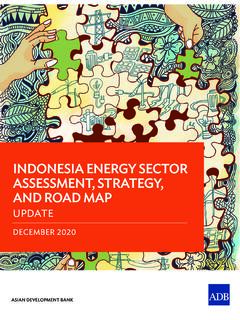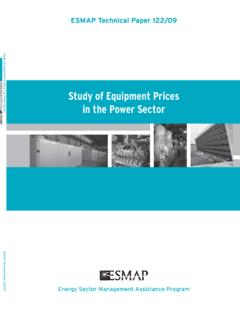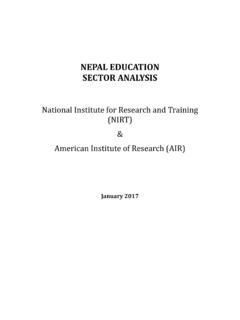Transcription of COVID-19 and the Informal Sector
1 1 POLICY BRIEFCOVID-19 and the Informal Sector : What it means for women now and in the futureRelated research is available at The COVID-19 pandemic has so far infected more than million people and claimed over 433,000 It has also had devastating impacts all around the world. It is projected that the global economy will shrink by some $ trillion an amount larger than the combined GDPs of Latin America and the Caribbean (LAC) and the Middle East and North Africa (MENA) The International Labor Organization (ILO) estimates that four out of five people in the global workforce of billion are currently not at work due to full or partial lockdown Economic recessions typically have uneven impacts on women and men, depending on their Sector , status in employment, and place of In 2008, for example, more men than women became unemployed because job losses were concentrated in male-dominated sectors such as construction and the current downturn, the adverse economic impact of COVID-19 has been most pressing for women, particularly women working in the Informal economy.
2 Nearly 432 million women in developing countries who are engaged in paid jobs work Further, the ILO estimates that 42 percent of Informal women workers are engaged in nonessential sectors,7 such as wholesale and trade, hospitality, and food A household survey from Kenya reports that more than half of working women have been rendered jobless by the coronavirus pandemic. 9 The COVID-19 pandemic and its socioeconomic effects have created a global crisis, unparalleled in history. The adverse economic impact of COVID-19 has been most pressing for women, and particularly women working in the Informal economy. This policy brief highlights the key impacts of the pandemic on women who work in the Informal economy in developing countries. It underscores their vulnerability to economic stress, as this demographic often lacks legal and social protections, and analyzes government responses to address the economic Turkan Mukhtarova | July 2020 PEACE & SECURITYCOVID-19 and the Informal Sector : What it means for women now and in the future1.
3 IntroductionGeorgetown Institute for Women, Peace and SecurityThis policy brief highlights the key impacts of the pandemic on women who work in the Informal economy in developing countries. It underscores their vulnerability to economic stress, as this demographic often lacks legal and social protections. Much of the research drawn on in the brief was done at the height of lockdown measures. However, as governments have begun rolling these restrictions back, we are seeing large increases in cases in countries that were spared initially, such as Brazil, India, and We may be going into a second wave of lockdowns as the pandemic 1 The Informal EconomySOURCE: European Union, Extending Coverage: Social Protection and the Informal Economy (Rome: RNSF, 2017), 8, InformalENTERPRISESWORKERSI nformalFormalInformal EconomyNot registered, don t pay tax, no accountsFormal EconomyRegistered, pay tax, maintain accountsSeasonal farm laborerHome-based WorkerDaily wage construction workerOwn-account taxi driverDomestic workerWaste pickerRickshaw driverSelf-employed vendorSelf-employed taxi driverTaxi driver enrolled in social security scheme who works in an Informal enterprise Civil servantSalaried employeeEmployed taxi driverWage laborer 2.
4 Preexisting Disparities and Current ChallengesOver 60 percent of all workers globally are informally employed: 90 percent in developing countries and 67 percent in emerging In 56 percent of countries, the percentage of women working in the Informal economy exceeds the percentage of In Sub-Saharan Africa and South Asia, over 70 percent of female employment is in the nonagricultural Informal Sector (Table 1). Stay-at-home orders, shrinking consumption, and declining demand in both the local and export markets are estimated to have cut Informal - Sector earnings by nearly 60 percent globally in the first month of the For women and their families already living in poverty, these impacts can be a shock to their economic stability overall. These shocks can impede their ability to purchase critical necessities, such as medicine and 1 The share and number of women working informally in developing countries by regionSOURCE: Author s calculations based on each region s most recent available data.
5 Data does not include agricultural employment. Regions do not include high-income countries classified by the World Bank. Source: Modeled ILO Estimates, ILOSTAT. Accessed on May 12, 2020. Available at and the Informal Sector : What it means for women now and in the futureREGIONSHARENUMBER (MILLIONS) East Asia & Pacific61%223 Europe & Central Asia25%17 Latin America & Caribbean64%68 Middle East & North Africa41% South Asia72%46 Sub-Saharan Africa79%73 Physical distancing is impossible in overcrowded urban neighborhoods and Informal settlements. Police harassment of Informal workers across all regions is resulting in the confiscation of goods, fines, or physical violence and abuse. Restrictions on mobility make it difficult for Informal workers to collect income support, since many do not have digital bank accounts or access to mobile money transfers.
6 Informal workers have limited access to information on the virus and how it spreads and have been the target of misinformation campaigns. Lockdown measures are increasing the threat of domestic violence for women Informal workers. Women Informal workers across all sectors are finding it more difficult to work due to an increase in childcare responsibilities as schools and childcare centers have : Impact of Public Health Measures on Informal Workers Livelihoods and Health (Manchester, UK: WIEGO, 2020), the world, the pandemic has resulted in a variety of challenges for women working in the Informal Sector in both urban and rural areas:Globally, street vendors and market traders who sell products other than food can no longer operate or are facing an increased risk of virus exposure. Street vendors an essential part of urban economies around the world account for a sizeable share of Informal employment: for example, 13 percent of nonagricultural employment in Senegal, 19 percent in Benin, and 24 percent in Togo.
7 Most street vendors worldwide are women (88 percent in Ghana, 68 percent in South Africa, and 63 percent in Kenya).15 Box 1: Common challenges faced by Informal workers in developing countriesGeorgetown Institute for Women, Peace and Security4 COVID-19 restrictions have slashed the incomes of street vendors In India, 90 percent of street vendors have not been able to While the government excluded carts selling food, grocery and dairy products from lockdown measures, restrictions continue to remain on street In Peru, fresh produce sellers face a different challenge. Although considered essential workers, they are not provided protective equipment by the government to allow them to work safely. Therefore, some vendors have become ill, others choose not to sell out of fear of getting the virus, and some sleep outside the market to avoid infecting family members at Massive layoffs for domestic workers have left women without compensation, and migrant workers are often the hardest hit.
8 There are more than 60 million domestic workers around the world, 80 percent of whom are Millions are experiencing job loss, delayed wages, and abuse by In 2019, only 30 countries had ratified the 2011 ILO Domestic Workers Convention (C189), which recognizes the right of domestic workers to decent working Domestic workers in countries that have not signed on to the convention have become particularly vulnerable during this In the Middle East, the situation is exacerbated due to the kafala (sponsorship) system. Migrant workers visas are often tied to their employer which creates a situation where they are unable to leave or change their employment without their employer s permission. Major shutdowns in large economies have cut demand for home-based workers, who produce goods or services in or near their homes for local, domestic, or global Home-based workers and enterprises are part of global value chains in high-end modern industries such as assembly work in electronics and packaging in pharmaceuticals and in traditional sectors like textiles, footwear, and artisanal A survey of 340 garment factories in India showed that 58 percent of surveyed factories outsource to Most of these home-based workers are women for example, over 70 percent in both Brazil and These dependent contractors are typically not covered by labor protections,28 have little control over when they work or their working conditions, and often have limited options for recourse for unfair During the lockdown.
9 There have been reports of home-based workers being unable to collect payments from previous Simultaneously, the market infrastructure for handicraft and handmade products has frozen, as products cannot be sold or and the Informal Sector : What it means for women now and in the futureIn India, 90 percent of street vendors have not been able to Institute for Women, Peace and Security6 The Self Employed Women s Association (SEWA) is an Indian trade union registered in 1972 that supports million poor, self-employed women workers operating in the Informal economy. SEWA s main goal is to organize women workers to obtain work security, income security, food security, and social security (at least health care, childcare, and shelter). The livelihoods of most of these workers are hard hit in some way or another by the pandemic. In the quotes below, SEWA members describe in their own words some of the challenges they are facing:Box 2: Voices from the front linesSOURCE: About Us, SEWA, accessed on May 12, 2020, have become prisoners in our homes.
10 I have a harvested cotton crop that I can t sell, a standing castor crop that I can t harvest, and a mounting debt that I can t repay. This Corona seems more like a livelihood threat than a health threat for poor Informal Sector women workers like me. Jamuben Ahir, a small farmer from Patan district of GujaratEveryone is sitting at home for past 8 days. My sons used to work at the local the stores are also closed. We don t have any cash on hand. Every year, I and my husband would work as agricultural laborers and help farmers in harvesting wheat. In return, farmers would give us wheat for our annual household consumption. This year there is no harvesting worst so don t know what will we eat The first thing you need in morning is tea but we don t have cash to buy tea leaves and sugar When my husband doesn t get his morning tea he gets very angry and hits me with whatever he can lay his hands on 55-year-old, KailashbenMore broadly, there is also a risk that temporary measures will not be reversed after the pandemic.




